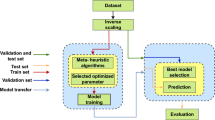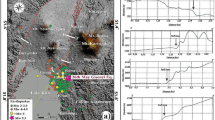Abstract
Earthquakes are one of the most important natural hazards to be evaluated carefully in engineering projects, due to the severely damaging effects on human-life and human-made structures. The hazard of an earthquake is defined by several approaches and consequently earthquake parameters such as peak ground acceleration occurring on the focused area can be determined. In an earthquake prone area, the identification of the seismicity patterns is an important task to assess the seismic activities and evaluate the risk of damage and loss along with an earthquake occurrence. As a powerful and flexible framework to characterize the temporal seismicity changes and reveal unexpected patterns, Poisson hidden Markov model provides a better understanding of the nature of earthquakes. In this paper, Poisson hidden Markov model is used to predict the earthquake hazard in Bilecik (NW Turkey) as a result of its important geographic location. Bilecik is in close proximity to the North Anatolian Fault Zone and situated between Ankara and Istanbul, the two biggest cites of Turkey. Consequently, there are major highways, railroads and many engineering structures are being constructed in this area. The annual frequencies of earthquakes occurred within a radius of 100 km area centered on Bilecik, from January 1900 to December 2012, with magnitudes (M) at least 4.0 are modeled by using Poisson-HMM. The hazards for the next 35 years from 2013 to 2047 around the area are obtained from the model by forecasting the annual frequencies of M ≥ 4 earthquakes.
Similar content being viewed by others
References
Zucchini W. and MacDonald I. L., Hidden Markov Models for Time Series: An Introduction Using R, Chapman & Hall/CRC Monographs on Statistics & Applied Probability, Boca Raton, USA, 2009
Baum L. E. and Petrie T., Statistical Inference for Probabilistic Functions of Finite State Markov Chains, The Annals of Mathematical Statistics, 37(1), 1966, 1554–1563
Orfanogiannaki K., Karlis D. and Papadopoulos G. A., Identifying Seismicity Levels via Poisson Hidden Markov Models, Pure and Applied Geophysics, 167, 2010, 919–931
Chambers D. W., Baglivo J. A., Ebel J. E. and Kafka A. L., Earthquake Forecasting Using Hidden Markov Models, Pure and Applied Geophysics, 169, 2012, 625–639
Cappe O., Moulines E. and Ryden T., Inference in Hidden Markov Models, Springer Science+Business Media, New York, USA, 2005
MacDonald I. L. and Zucchini W., Hidden Markov Models and Other Models for Discrete-Valued Time Series, Chapman & Hall/CRC Monographs on Statistics & Applied Probability, London, UK, 1997
Can C. E., Ergun, G., Gokceoglu C., Bilecik çevresinde deprem tehlikesinin saklı Markov modeli ile tahmini. Proceedings of the Second Turkey Earthquake Engineering and Seismology Conference, 25–27 Eylül 2013 — MKÜ — Hatay, Turkey (in Turkish), 2013
Ocakoglu F., Acikalin S., Gokceoglu C., Nefeslioglu H. A., Sonmez, H., Back-analysis of the source of the 1956 Eskisehir Earthquake using attenuation equation and damage data, Bull Eng Geol Environ, 66, 2007, 353–360
UIDM, Boǧaziçi University, Kandilli Observatory and Earthquake Research Institute, Web Address: http://www.koeri.boun.edu.tr/, 2013
Boore D. M., Joyner W. B., Fumal T. E., Equations for estimating horizontal response spectra and peak acceleration from western North American earthquakes: a summary of recent work, Seismol. Res. Lett., 68(1), 1997, 128–153
Campbell K. W., Empirical near source attenuation relationships for horizontal and vertical components of peak ground acceleration, peak ground velocity, and pseudo-absolute acceleration response spectra, Seismol. Res. Lett., 68(1), 1997, 154–179
Sadigh K., Chang C. Y., Egan J. A., Makdisi F., Youngs R. R., Attenuation relationships for shallow crustal earthquakes based on California strong motion data, Seismol. Res. Lett., 1(68), 1997, 180–189
Ulusay R., Tuncay E., Sonmez H., Gokceoglu C., An attenuation relationship based on Turkish strong motion data and iso-acceleration map of Turkey, Engineering Geology, 74, 2004, 265–291
Rabiner L. R., A Tutorial on Hidden Markov Models and Selected Applications in Speech Recognition, Proceedings of the IEEE, 77(2), 1989, 257–285
Rabiner L. R. and Juang B. -H., Fundamentals of Speech Recognition, Prentice-Hall, New Jersey, USA, 1993
Jelinek F., Statistical Methods for Speech Recognition, MIT Pres, USA, 1997
Hamilton J. D., Time Series Analysis. Princeton University Press, New Jersey, USA, 1994
Rydén T., Teräsvirta and Asbrink S., Stylized facts of daily returns series and the Hidden Markov Model, Journal of Applied Econometrics, 13, 1998, 217–244
Kim C. -J. and Nelson, C. R., State-Space Models with Regime Switching: Classical and Gibbs-Sampling Approaches with Applications, MIT Press, USA, 1999
A., Ruggeri F. and Soyer R., A Bayesian Hidden Markov Model for Imperfect Debugging, Reability Engineering and System Safety, 103, 2012, 11–21
Landon J., Özekici S. and Soyer R., A Markov Modulated Poisson Model for Software Reability, European Journal of Operational Research, 229, 2013, 404–410
Dainotti A., Pescapé A., Rossi P. S., Palmieri F., and Ventre G., Internet Traffic Modelling by Means of Hidden Markov Models, Computer Networks, 52(14), 2008, 2645–2662
Leroux B. G. and Puterman M. L., Maximum-Penalized-Likelihood Estimation for Independent and Markov-Dependent Mixture Models, Biometrics, 48(2), 1992, 545–558
Cave R. L. and Neuwirth L. P., Hidden Markov Models for English, In Proceedings of the Symposium on the Application of Hidden Markov Models to Text and Speech (Ferguson J. D. Editor), Princeton, New Jersey: IDA-CRD, 16–56, 1980
Charniak E., Statistical Language Learning, MIT Press, Massachusetts, 170, 1993
Zucchini W. and Guttorp P., A Hidden Markov Model for Space-Time Precipitation, Water Resources Research, 27(8), 1991, 1917–1923
Sansom J., A Hidden Markov Model for Rainfall Using Breakpoint Data, Journal of Climate, 11, 1998, 42–53
Bellone E., Hughes J. P. and Guttorp P., A hidden Markov model for downscaling synoptic atmospheric patterns to precipitation amounts, Climate Research, 15, 2000, 1–12
Robertson A. W., Kirshner S. and Smyth P., Downscaling of Daily Rainfall Occurrence over Northeast Brazil Using a Hidden Markov Model, Journal of Climate, 17, 2004, 4407–4424
Baldi P., Hunkapiller T., Chauvin Y. and McClure, M. A., Hidden Markov Models of Biological Primary Sequence Infromation, In Proceedings of National Academy of Science USA, Vol. 91, 1994, 1059–1063
Krogh A., Brown M., Mian I. S., Sjölander K. and Haussler D., Hidden Markov models in computational biology: Applications to protein modeling, Journal of Molecular Biology, 235, 1994, 1501–1531
Durbin R., Eddy S., Krogh A. and Mitchison G., Biological Sequence Analysis: Probabilistic Models of Proteins and Nucleic Acids. Cambridge University Press, Cambridge, England, 1998
Koski T., Hidden Markov Models for Bioinformatics. Kluwer Academic Publishers, USA, 2001
Fredkin D. R. and Rice J. A., Bayesian Restoration of Single-channel Patch Clamp Recordings, Biometrics, 48(2), 1992, 427–448
Fredkin D. R. and Rice J. A., Maximum Likelihood Estimation and Identification Directly from Singlechannel Recordings, Proceedings: Biological Science, 249, 1992, 125–132
Ball F. G., Cai Y., Kadane J. B. and O’Hagan A., Bayesian Inference for Ion-Channel Gating Mechanisms Directly from Single-Channel Recordings, Using Markov Chain Monte Carlo. Proceedings Royal Society London A, 455, 1999, 2879–2932
Granat R. and Donnellan A., A Hidden Morkov Model Based Tool for Geophysical Data Exploration, Pure and Applied Geophysics, 159(10), 2002, 2271–2283
Chambers D. W., Ebel J. E., Kafka A. L. and Baglivo J. A., Hidden Markov Approach to Modeling Interevent Earthquake Times, Eos. Trans. AGU, 84(46), 2003, Fall Meet. Suppl., Abstract S52F-0179
Ebel J. E., Chambers D. W., Kafka A. L. and Baglivo J. A., Non-Poissonian Earthquake Clustering and the Hidden Markov Model as Bases for Earthquake Forecasting in California, Seismological Research Letters, 78(1), 2007, 57–65
Orfanogiannaki K., Karlis D. and Papadopoulos G. A., Identification of Temporal Patterns in the Seismicity of Sumatra Ruprue Zone Using Poisson Hidden Markov Models, Geophysical Research Abstracts, Volume 8, 2006
Orfanogiannaki K., Karlis D. and Papadopoulos G. A., Application of Poisson Hidden Markov Models on Foreshock Sequence: The case of Samos, October 2005 and Zakynthos, April 2006, Earthquakes, XIIth Int. Conf. Appl. Stochastic Models and Data Analysis, Chania, Crete, Greece, 2007
Wu Z., A Hidden Markov Model for Earthquake Declustering, Journal of Geophysical Research, 115, 2010
Ephraim Y. and Merhav N., Hidden Markov Processes, IEEE Transactions On Information Theory, 48:6, 2002, 1518–1569
Ghahramani Z., An Introduction to Hidden Markov Models and Bayesian Networks, International Journal of Pattern Recognition and artificial Intelligence, 15:1, 2001, 9–42
Alpaydın E., Introduction to Machine Machine Learning, The MIT Press, Cambridge, USA, 2010
Ibe O. C., Markov Process for Stochasting Modelling, Elsevier Aacademic Press, California, USA, 2010
Akaike H., A New Look at the Statistical Model Identification, IEEE Transactions on Automatic Control, AC-19, 1974, 716–723
Schwarz G., Estimating the Dimension of a Model, Annals of Statistics, 6, 1978, 461–464
Author information
Authors and Affiliations
Corresponding author
About this article
Cite this article
Can, C.E., Ergun, G. & Gokceoglu, C. Prediction of earthquake hazard by hidden Markov model (around Bilecik, NW Turkey). cent.eur.j.geo. 6, 403–414 (2014). https://doi.org/10.2478/s13533-012-0180-1
Received:
Accepted:
Published:
Issue Date:
DOI: https://doi.org/10.2478/s13533-012-0180-1




